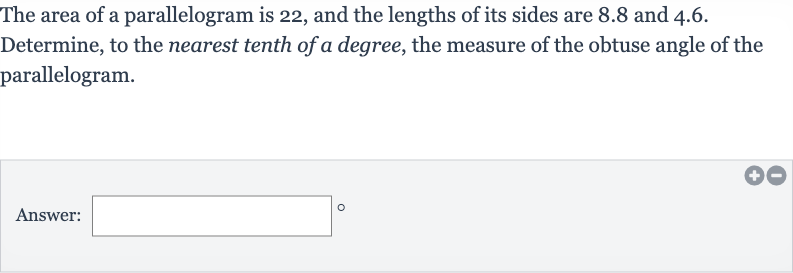Full solution
Q. The area of a parallelogram is , and the lengths of its sides are . and . . Determine, to the nearest tenth of a degree, the measure of the obtuse angle of the parallelogram.Answer:
- Area Formula Explanation: The area of a parallelogram is given by the formula , where the base is the length of one side and the height is the perpendicular distance from the base to the opposite side.
- Given Values: We are given the area and the lengths of the sides are and . We can assume that one of these sides is the base. Without loss of generality, let's take the side of length as the base.
- Calculate Height: To find the height , we use the area formula: . Plugging in the values we have, we get .
- Calculate Sine of Angle: Solving for , we divide both sides of the equation by to get .
- Calculate Acute Angle: Calculating the height , we get .
- Calculate Obtuse Angle: Now that we have the height, we can find the sine of the acute angle between the base and the height using the formula , where the opposite side is the height and the hypotenuse is the side length of .
- Calculate Obtuse Angle: Now that we have the height, we can find the sine of the acute angle between the base and the height using the formula , where the opposite side is the height and the hypotenuse is the side length of . Plugging in the values, we get .
- Calculate Obtuse Angle: Now that we have the height, we can find the sine of the acute angle between the base and the height using the formula , where the opposite side is the height and the hypotenuse is the side length of . Plugging in the values, we get . Calculating , we get .
- Calculate Obtuse Angle: Now that we have the height, we can find the sine of the acute angle between the base and the height using the formula , where the opposite side is the height and the hypotenuse is the side length of . Plugging in the values, we get . Calculating , we get . To find the measure of the acute angle , we take the inverse sine (arcsin) of .
- Calculate Obtuse Angle: Now that we have the height, we can find the sine of the acute angle between the base and the height using the formula , where the opposite side is the height and the hypotenuse is the side length of . Plugging in the values, we get . Calculating , we get . To find the measure of the acute angle , we take the inverse sine (arcsin) of . Calculating , we get .
- Calculate Obtuse Angle: Now that we have the height, we can find the sine of the acute angle between the base and the height using the formula , where the opposite side is the height and the hypotenuse is the side length of . Plugging in the values, we get . Calculating , we get . To find the measure of the acute angle , we take the inverse sine (arcsin) of . Calculating , we get . Since we are looking for the measure of the obtuse angle, and we know that the sum of the angles in a parallelogram is , with opposite angles being equal, the obtuse angle is .
- Calculate Obtuse Angle: Now that we have the height, we can find the sine of the acute angle between the base and the height using the formula , where the opposite side is the height and the hypotenuse is the side length of . Plugging in the values, we get . Calculating , we get . To find the measure of the acute angle , we take the inverse sine (arcsin) of . Calculating , we get . Since we are looking for the measure of the obtuse angle, and we know that the sum of the angles in a parallelogram is , with opposite angles being equal, the obtuse angle is . Calculating the obtuse angle, we get .
More problems from Find the magnitude of a three-dimensional vector
QuestionGet tutor help
QuestionGet tutor help
QuestionGet tutor help
QuestionGet tutor help
QuestionGet tutor help
QuestionGet tutor help

